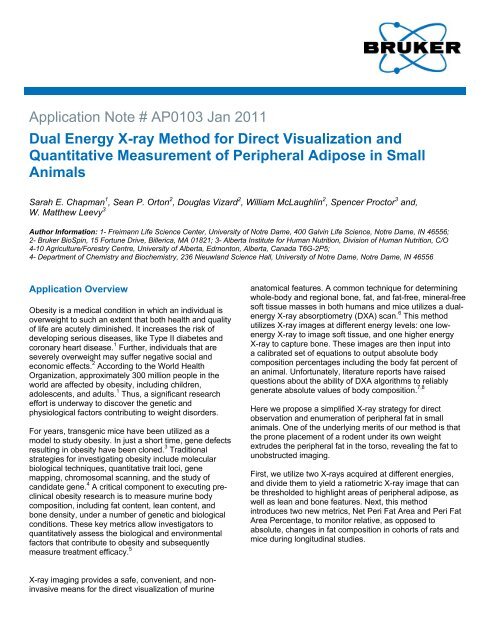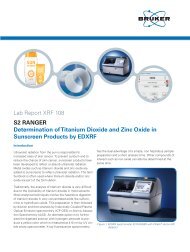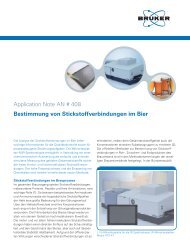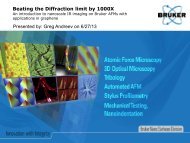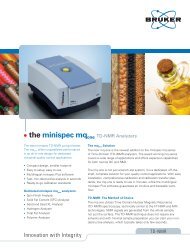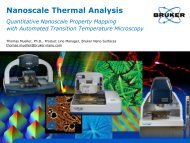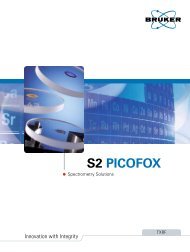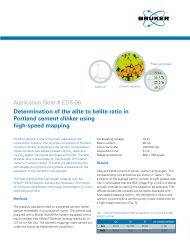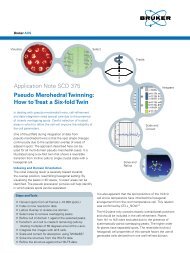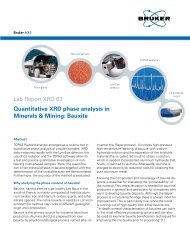AP0103 - Measurement of Peripheral Adipose in Small ... - Bruker
AP0103 - Measurement of Peripheral Adipose in Small ... - Bruker
AP0103 - Measurement of Peripheral Adipose in Small ... - Bruker
Create successful ePaper yourself
Turn your PDF publications into a flip-book with our unique Google optimized e-Paper software.
Application Note # <strong>AP0103</strong> Jan 2011Dual Energy X-ray Method for Direct Visualization andQuantitative <strong>Measurement</strong> <strong>of</strong> <strong>Peripheral</strong> <strong>Adipose</strong> <strong>in</strong> <strong>Small</strong>AnimalsSarah E. Chapman 1 , Sean P. Orton 2 , Douglas Vizard 2 , William McLaughl<strong>in</strong> 2 , Spencer Proctor 3 and,W. Matthew Leevy 3Author Information: 1- Freimann Life Science Center, University <strong>of</strong> Notre Dame, 400 Galv<strong>in</strong> Life Science, Notre Dame, IN 46556;2- <strong>Bruker</strong> BioSp<strong>in</strong>, 15 Fortune Drive, Billerica, MA 01821; 3- Alberta Institute for Human Nutrition, Division <strong>of</strong> Human Nutrition, C/O4-10 Agriculture/Forestry Centre, University <strong>of</strong> Alberta, Edmonton, Alberta, Canada T6G-2P5;4- Department <strong>of</strong> Chemistry and Biochemistry, 236 Nieuwland Science Hall, University <strong>of</strong> Notre Dame, Notre Dame, IN 46556Application OverviewObesity is a medical condition <strong>in</strong> which an <strong>in</strong>dividual isoverweight to such an extent that both health and quality<strong>of</strong> life are acutely dim<strong>in</strong>ished. It <strong>in</strong>creases the risk <strong>of</strong>develop<strong>in</strong>g serious diseases, like Type II diabetes andcoronary heart disease. 1 Further, <strong>in</strong>dividuals that areseverely overweight may suffer negative social andeconomic effects. 2 Accord<strong>in</strong>g to the World HealthOrganization, approximately 300 million people <strong>in</strong> theworld are affected by obesity, <strong>in</strong>clud<strong>in</strong>g children,adolescents, and adults. 1 Thus, a significant researcheffort is underway to discover the genetic andphysiological factors contribut<strong>in</strong>g to weight disorders.For years, transgenic mice have been utilized as amodel to study obesity. In just a short time, gene defectsresult<strong>in</strong>g <strong>in</strong> obesity have been cloned. 3 Traditionalstrategies for <strong>in</strong>vestigat<strong>in</strong>g obesity <strong>in</strong>clude molecularbiological techniques, quantitative trait loci, genemapp<strong>in</strong>g, chromosomal scann<strong>in</strong>g, and the study <strong>of</strong>candidate gene. 4 A critical component to execut<strong>in</strong>g precl<strong>in</strong>icalobesity research is to measure mur<strong>in</strong>e bodycomposition, <strong>in</strong>clud<strong>in</strong>g fat content, lean content, andbone density, under a number <strong>of</strong> genetic and biologicalconditions. These key metrics allow <strong>in</strong>vestigators toquantitatively assess the biological and environmentalfactors that contribute to obesity and subsequentlymeasure treatment efficacy. 5anatomical features. A common technique for determ<strong>in</strong><strong>in</strong>gwhole-body and regional bone, fat, and fat-free, m<strong>in</strong>eral-frees<strong>of</strong>t tissue masses <strong>in</strong> both humans and mice utilizes a dualenergyX-ray absorptiometry (DXA) scan. 6 This methodutilizes X-ray images at different energy levels: one lowenergyX-ray to image s<strong>of</strong>t tissue, and one higher energyX-ray to capture bone. These images are then <strong>in</strong>put <strong>in</strong>toa calibrated set <strong>of</strong> equations to output absolute bodycomposition percentages <strong>in</strong>clud<strong>in</strong>g the body fat percent <strong>of</strong>an animal. Unfortunately, literature reports have raisedquestions about the ability <strong>of</strong> DXA algorithms to reliablygenerate absolute values <strong>of</strong> body composition. 7,8Here we propose a simplified X-ray strategy for directobservation and enumeration <strong>of</strong> peripheral fat <strong>in</strong> smallanimals. One <strong>of</strong> the underly<strong>in</strong>g merits <strong>of</strong> our method is thatthe prone placement <strong>of</strong> a rodent under its own weightextrudes the peripheral fat <strong>in</strong> the torso, reveal<strong>in</strong>g the fat tounobstructed imag<strong>in</strong>g.First, we utilize two X-rays acquired at different energies,and divide them to yield a ratiometric X-ray image that canbe thresholded to highlight areas <strong>of</strong> peripheral adipose, aswell as lean and bone features. Next, this method<strong>in</strong>troduces two new metrics, Net Peri Fat Area and Peri FatArea Percentage, to monitor relative, as opposed toabsolute, changes <strong>in</strong> fat composition <strong>in</strong> cohorts <strong>of</strong> rats andmice dur<strong>in</strong>g longitud<strong>in</strong>al studies.X-ray imag<strong>in</strong>g provides a safe, convenient, and non<strong>in</strong>vasivemeans for the direct visualization <strong>of</strong> mur<strong>in</strong>e
with<strong>in</strong> animal cohorts dur<strong>in</strong>g longitud<strong>in</strong>al studies.In order to ma<strong>in</strong>ta<strong>in</strong> maximal objectivity, a researcherbl<strong>in</strong>ded to the experimental protocol should draw theabove ROIs. In addition, if this method were applied tomice, higher throughput could likely be achieved as aresult <strong>of</strong> the larger imag<strong>in</strong>g area <strong>of</strong> up to 20 x 20 cm <strong>in</strong>the In-Vivo MS FX PRO or the In-Vivo DXS PRO. Thislarger imag<strong>in</strong>g area would allow for up to five mice to bestudied at one time.ConclusionHere we describe an approach to facilitate directobservation and quantification <strong>of</strong> peripheral fat with<strong>in</strong>small animals. A ratiometric X-ray image is acquired toenable robust contrast <strong>of</strong> peripheral fat and lean/bonecomponents. These anatomical features can bedel<strong>in</strong>eated and measured by straightforward ROIanalysis <strong>of</strong> the circumscribed areas. These areas are auseful metric on their own and also upon conversion toarea percentages.Based on these results, different cohorts <strong>of</strong> fat and leananimals may be readily compared us<strong>in</strong>g visual <strong>in</strong>spectionand quantitative analysis. These same parameters shouldenable facile analysis <strong>of</strong> cohorts dur<strong>in</strong>g longitud<strong>in</strong>al studies<strong>in</strong> which body fat changes over time under variousexperimental conditions.References1) Brockman G, Bevova M, TRENDS <strong>in</strong> Genetics 2002,18(7), 367-376.2) Clarke PJ, O'Malley PM, Schulenberg JE, JohnstonLD. Am. J. Epidemiol. 2010 Jul 7.3) Bray GA, J. Nutr. 1997, 127(5 Suppl), 940S-942S.Review.4) Bray GA, Bouchard C, FASEB J. 1997, 11, 937-945.5) Carroll L, Voisey J, Van Daal A, Cl<strong>in</strong>. Dermatol. 2004,22, 345-349.6) Lukaski H, J. Nutr. 1993, 123(2 Suppl), 438-43.Review.7) Johnston, S. L. et al. Obes. Res. 2005, 13(9), 1558-1565.8) Nagy, T. R. et al. Obes. Res. 2000, 8(5), 392-398.For more <strong>in</strong>formation, contact your<strong>Bruker</strong> BioSp<strong>in</strong> dealer, or contact us directly at:Telephone:Call 1-978-667-9580 and select Option 4.Mon. through Fri., 8:00 a.m. – 6:00 p.m. ESTE-mail:molecularsupport@bruker.comWeb:http://www.bruker.com<strong>Bruker</strong> BioSp<strong>in</strong> is a division <strong>of</strong> <strong>Bruker</strong>, Inc. and is atrademark <strong>of</strong> <strong>Bruker</strong>, Inc. All other products or namebrands are trademarks <strong>of</strong> their respective holders.© <strong>Bruker</strong> BioSp<strong>in</strong>, 2012. All rights are reserved. Nosection <strong>of</strong> this document may be photocopied,reproduced, translated to another language, stored <strong>in</strong> aretrieval system, or transmitted <strong>in</strong> any form without theprior written consent <strong>of</strong> <strong>Bruker</strong> BioSp<strong>in</strong>.The <strong>in</strong>formation conta<strong>in</strong>ed <strong>in</strong> this document is subject tochange without notice. <strong>Bruker</strong> BioSp<strong>in</strong> makes nowarranty <strong>of</strong> any k<strong>in</strong>d with regard to this written material.<strong>Bruker</strong> BioSp<strong>in</strong> assumes no responsibility for any errorsthat may appear <strong>in</strong> this document.4


